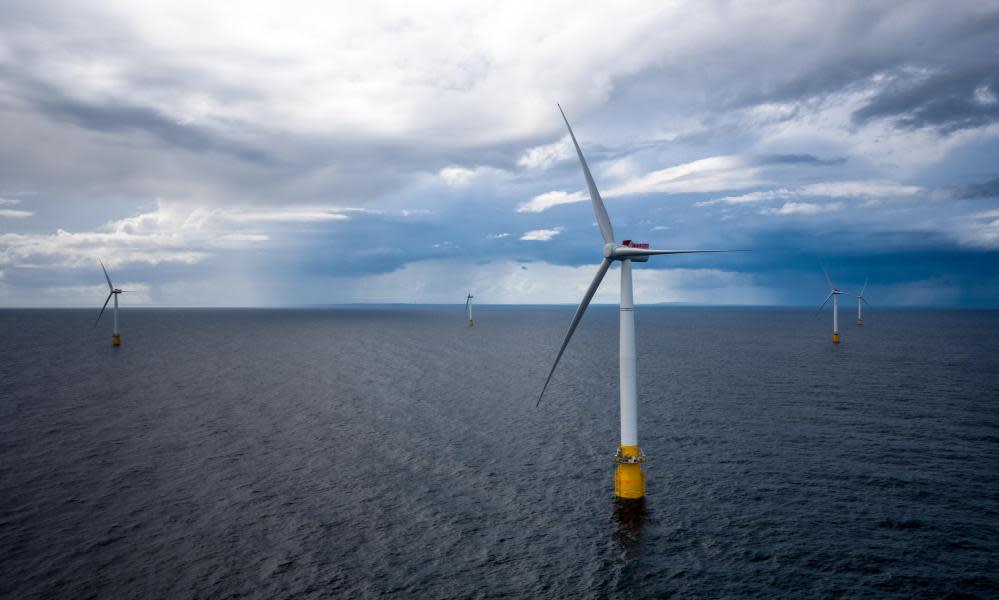Scottish auction for offshore windfarm permits expected to raise £860m

Scotland’s largest-ever auction of permits to construct offshore windfarms is expected to raise up to £860m when the results are announced on Monday.
Crown Estate Scotland, which is running the auction, hopes that windfarms with as much as 10 gigawatts of new generating capacity will be built over the next decade, effectively doubling the amount of electricity generated in Scottish waters in a transition which has the potential to create tens of thousands of jobs.
The programme, known as ScotWind, has attracted frenzied interest from domestic and international bidders, and could set new records for values placed on the plots of seabed being leased for turbines.
In the first ScotWind leasing round, 8,600 sq km of Scottish seabed is on offer across 15 areas, enough to develop windfarms which could power every Scottish household and save more than 6m tonnes of carbon dioxide a year.
The windfarms could more than double the capacity built or planned in the seabed around Scotland over the coming decade. At the moment, offshore windfarms in Scotland generate about 1GW. Projects that have received consent and those being built amount to less than 10GW.
The Moray East windfarm has become Scotland’s biggest source of renewable energy, generating up to 950 megawatts from 100 turbines. It will be overtaken by Seagreen next year with 1GW of capacity. Located around 27km off the Angus coast, the £3bn windfarm is a joint venture between Perth-based SSE Renewables (49%) and France’s TotalEnergies (51%).
The winning bids – and the prices paid – are expected to be announced at 10am on Monday. Crown Estate said in July that 74 offers had been submitted for ScotWind. Many come from consortiums.
Among them is Denmark’s largest energy company Ørsted, which pioneered the first ever offshore windfarm in 1991 and has teamed up with Italy’s Falck Renewables and the floating wind expert BlueFloat Energy.
Other bidders include renewable energy investment funds such as Australia’s Macquarie Bank Green Investment Group, which has partnered with the Scottish offshore wind developer Renewable Infrastructure Development Group; big utility companies involved in existing projects, such as SSE and Scottish Power; and large oil companies, including Shell, France’s Total, Italy’s ENI and Norway’s Equinox.
Crown Estate Scotland lifted the cap for the auction bids from £10,000 to £100,000 per sq km last year. If every bid is submitted up to that maximum cap, the sale could raise £860m.
Melanie Grimmitt, global head of energy at the law firm Pinsent Masons, said this leasing round had shown that there was significant appetite for investment from within the UK and abroad, which bodes well for a second ScotWind seabed leasing round later this year.
“This is crown state Scotland’s first seabed leasing round and marks an important chapter for Scotland’s offshore market, but with proposed windfarms from the leasing round expected to save in excess of 6m tonnes of carbon emissions, it is also an important milestone for the UK’s overall net zero commitments,” she said.
“Developers will be keeping an eye out to see if and how the application process and criteria for the next round might differ from this one given how popular and competitive it has been.”
Crown Estate Scotland is a separate organisation to the crown estate, which manages the Queen’s assets in England and Wales, and its profit is passed to the Scottish government. Some of the proceeds are expected to be ploughed into preparing the workforce for the switch from North Sea oil and gas to wind power. The transition to renewable energy means that as fossil fuel jobs disappear, thousands of workers will need retraining.

 Yahoo News
Yahoo News 
